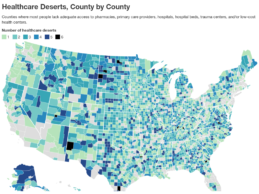The fastest way to access healthcare in the United States isn’t through a primary care physician or urgent care or orchestrated referrals processes. It comes through three taps of a button: Nine, one, and one.
Dialing 911 during a medical emergency is a straightforward process: Callers are routed to the correct dispatcher, resources are deployed quickly and effectively, and patients are transported to the correct facility to receive care. Through three simple numbers, you are whisked
Read More
Public Health
Why The End of the Public Health Emergency is Everyone’s Problem
The COVID-19 pandemic led to sweeping healthcare policy changes that enable vulnerable Americans to receive affordable health coverage and access essential safety net benefits. The steep incline in unemployment and fears that millions of people would lose their health coverage drove the declaration of the national public health emergency (PHE) on January 31, 2020. Under the PHE, states must keep Medicaid enrollees continuously covered, irrespective of their circumstances.
With the PHE set
Read More
Cedars-Sinai Establishes New Division: Artificial Intelligence in Medicine (AIM)
What You Should Know:
- Today, the department of Cedars-Sinai announced it has established a new division to explore how artificial intelligence (AI) can be applied to help solve complex medical problems and enhance clinical care.
- The new division, Artificial Intelligence in Medicine, or AIM will be led by Sumeet Chugh, MD, an associate director of the Smidt Heart Institute and a prominent expert in sudden cardiac arrest, who has long relied on technology and population-wide data to help
Read More
NourishedRx Raises $6M to Accelerate Intelligent Food-for-Health Platform
What You Should Know:
- NourishedRx, a digital health company raises $6M in seed funding led by S2G Ventures with additional investors Route 66 Ventures, Connecticut Innovations, Primetime Partners, and other individual investors.
- The company will utilize the funding to expand its high-tech, a high-touch platform to provide personalized, culturally relevant food solutions to health plan members nationwide.
Personalized Nutrition
Founded in 2019, with the support of the Mailman
Read More
Innovaccer Offers Public Health Command Center at No Cost to Assist with Omicron Surge
What You Should Know:
- Innovaccer has launched Public Health Command Center, an innovative solution designed to help hospitals fight the pandemic more effectively at scale. It seamlessly integrates Innovaccer’s proven COVID-19 Command Center with a COVID-focused version of Innovaccer’s new Patient Relationship Management solution. And it’s available at no cost to public health departments and hospitals for the first three months of use.
- Powered by the Innovaccer Health
Read More
Children’s COVID-19 Vaccine: A Key to Protecting Pediatric Asthma Patients
What Has Everyone Excited about COVID-19 Vaccines for 5-11-year-olds?
With the rollout this month of the COVID-19 vaccine for those 5-11 years of age, we can now directly protect children with asthma for whom COVID-19 infection is an even bigger hazard for our children during the pandemic.
During the COVID-19 pandemic, the term “comorbidities” has entered our daily vernacular, mostly in reference to adults’ chronic illnesses such as cancer, heart disease and diabetes, but with pediatric
Read More
Color Raises $100M at $4.6B Valuation to Expand Accessible, Equitable Public Health Infrastructure
What You Should Know:
- Color, a San Francisco, CA-based health technology company committed to advancing public health, announced a $100 million Series E financing round at a valuation of $4.6 billion led by Kindred Ventures and by certain funds and accounts advised by T. Rowe Price Associates, Inc. with participation by existing investors General Catalyst, Viking Global Investors, and Emerson Collective.
- Color makes population-scale healthcare programs accessible, convenient, and
Read More
Healthcare Deserts: 80% of U.S. Lacks Adequate Access to Healthcare
What You Should Know:
- Over 80 percent of the country lacks adequate healthcare infrastructure in some shape or form, according to recent report findings from GoodRx Research. The research finds that over a third of the U.S. population lives in a county where there is less than adequate access to pharmacies, primary care providers, hospitals, trauma centers, and/or low-cost health centers.
- The report offers an in-depth look at the uneven distribution of healthcare across the
Read More
How Healthcare Can Weaponize Data to Fight Worldwide Disease
After more than a year since COVID-19 became a global pandemic, we now understand that part of the challenge in fighting it, and any infectious disease, is solving the underlying data problem.
Without reliable data, leaders can’t plan, epidemiologists can’t model, and citizens don’t feel confident following expert recommendations. Bad data has led to both poor behavioral and policy-oriented decisions, exacerbating COVID-19 and prolonging its consequences.
It’s not purely a data problem,
Read More
Streamline Locally to Increase Efficiency, Battle COVID Globally
People tend to think of COVID-19 as a national or even worldwide crisis. The pandemic is everywhere, after all, and we tend to judge entire nations by their reaction to the disaster and how that reaction endangers or protects the countries around them. But a pandemic is made of millions of individual stories, and those stories, whether close calls or tragedies, all take place on the ground at the local level.
While each patient’s local public health department is ultimately responsible
Read More











